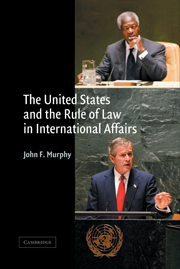Book contents
- Frontmatter
- Contents
- Acknowledgments
- Introduction
- 1 Law and legal process in international affairs
- 2 The status of international law under US law
- 3 UN dues
- 4 Use of force
- 5 Arms control, disarmament, nonproliferation, and safeguards
- 6 The law of the sea
- 7 The International Court of Justice
- 8 Prevention, prosecution, and punishment of international crimes
- 9 Human rights and international environmental issues
- 10 Summary and conclusions, and some possible future scenarios
- Index
5 - Arms control, disarmament, nonproliferation, and safeguards
Published online by Cambridge University Press: 22 September 2009
- Frontmatter
- Contents
- Acknowledgments
- Introduction
- 1 Law and legal process in international affairs
- 2 The status of international law under US law
- 3 UN dues
- 4 Use of force
- 5 Arms control, disarmament, nonproliferation, and safeguards
- 6 The law of the sea
- 7 The International Court of Justice
- 8 Prevention, prosecution, and punishment of international crimes
- 9 Human rights and international environmental issues
- 10 Summary and conclusions, and some possible future scenarios
- Index
Summary
In this chapter we consider the closely related subjects of arms control, disarmament, nonproliferation, and safeguards. All of these subjects are, in turn, closely related to regulation of the use of force. Indeed, as we have seen in chapter 4, Security Council Resolution 687 constitutes an unprecedented effort to force a member state of the United Nations unilaterally to disarm with respect to weapons of mass destruction.
Traditionally, all of these subjects, especially arms control and disarmament, have been subject to an extensive network of multilateral and bilateral treaties. Many, indeed most, of these treaties were concluded with strong US support. It is clear, however, that, with the second Bush administration, there has been a sea change in US attitudes toward such treaties. Reflecting in large part the substantial distrust of John Bolton of arms control and multilateral treaties, the Bush administration “has pulled out of the Anti-Ballistic Missile Treaty with Russia, scuttled an important protocol to the biological-weapons ban, ousted the head of the organization that oversees the chemical weapons ban, watered down an accord on small-arms trafficking and refused to submit the nuclear test ban treaty for Senate ratification [actually Senate advice and consent to ratification].”
Reportedly, the view of the Bush administration is that treaties on arms control, disarmament, and, to a lesser extent, nonproliferation at best do not work and at worst can endanger vital US interests. It appears especially skeptical of multilateral treaties that set up verification and enforcement regimes.
- Type
- Chapter
- Information
- The United States and the Rule of Law in International Affairs , pp. 207 - 225Publisher: Cambridge University PressPrint publication year: 2004



